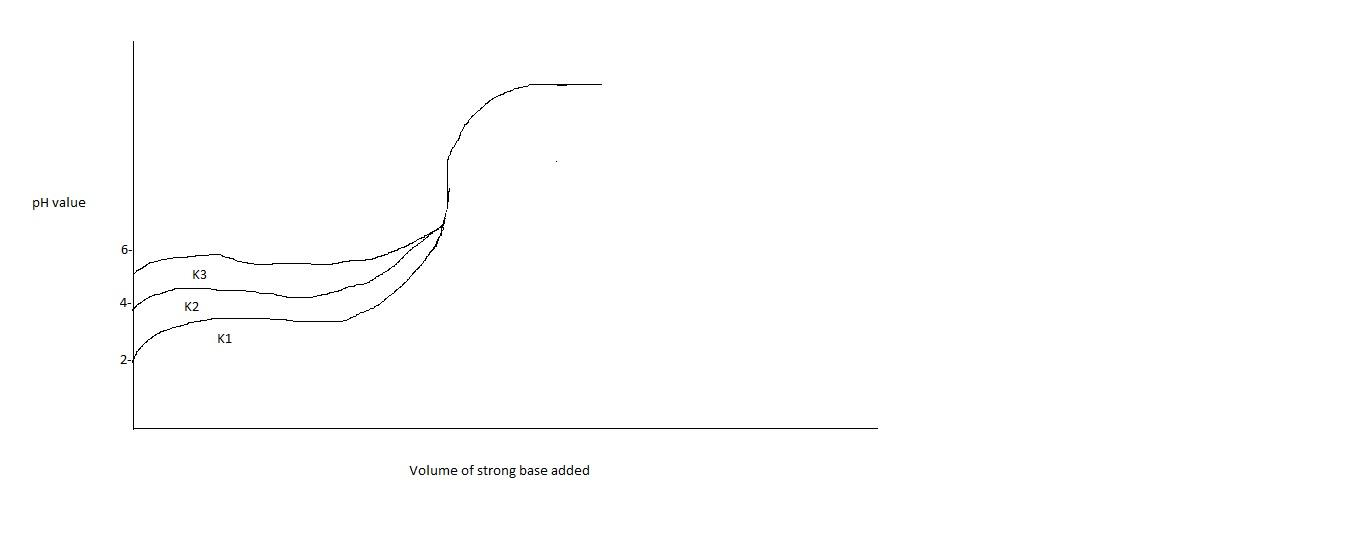
Titration curves for $0.1{\text{M}}$ solutions of three weak acids ${\text{H}}{{\text{A}}_1},{\text{H}}{{\text{A}}_2},{\text{H}}{{\text{A}}_3}$ with ionization constants ${{\text{K}}_1},{{\text{K}}_2},{{\text{K}}_3}$ respectively are plotted in the figure. Which of the following is/are true?

A. \[{{\text{K}}_2} = \dfrac{{\left( {{{\text{K}}_1} + {{\text{K}}_3}} \right)}}{2}\]
B. ${{\text{K}}_1} < {{\text{K}}_3}$
C. ${{\text{K}}_1} > {{\text{K}}_2}$
D. ${{\text{K}}_2} > {{\text{K}}_3}$

Answer
564.6k+ views
Hint:Ionization constant of an acid is the equilibrium constant for the reaction of a weak acid with water. Similarly the ionization constant of a base is the equilibrium constant for the reaction of a weak base with water. Acid strength increases with ionization constant.
Complete step by step answer:
Acids are generally defined as the hydrogen containing compounds and bases are the hydroxide containing compounds. Ionization is the process in which individual positive and negative ions are produced from a molecular compound that is dissolved in a solution. While dissociation is the process in which positive and negative ions are released from an ionic compound that is dissolved in a solution. Weak acids transfer only a small percentage of its protons to water in aqueous solution.
In the titration curve of weak acids, only a fraction of weak acid is dissociated. Before adding the base, ${\text{pH}}$ of the weak acid is greater than that of strong acid. Initially the ${\text{pH}}$ changes rapidly. At an equivalence point (the point at which neutralization is complete), the solution becomes basic. When the acid is neutralized, ${\text{pH}}$ is influenced by the addition of base in excess. Ionization constant is the equilibrium constant. When ionization constant is increased, ${\text{pH}}$ is increased.
Thus from graph, we can tell that ${{\text{K}}_1}$ has less value than ${{\text{K}}_2}$ and ${{\text{K}}_3}$. Moreover, ${{\text{K}}_2}$ is in the middle of ${{\text{K}}_1}$ and ${{\text{K}}_3}$. Therefore option A will be correct. ${{\text{K}}_2}$ will be the average of ${{\text{K}}_1}$ and ${{\text{K}}_3}$. Moreover, option B is also correct, i.e. ${{\text{K}}_1} < {{\text{K}}_3}$.
Thus options A and B are correct.
Additional information:
${\text{pH}}$ is calculated from the value of $\left[ {{{\text{H}}_3}{{\text{O}}^ + }} \right]$. It is the negative algorithm of hydronium ion concentration. In pure water hydronium concentration is the same as that of hydroxide ion concentration.
Note:
In any acid-base reaction, the equilibrium will favor the reaction that moves the proton to the stronger base. When ${\text{HCl}}$ is used, since water is stronger than ${\text{C}}{{\text{l}}^ - }$, equilibrium moves to the right. During auto-ionization, the ionization constant is called the ion-product constant.
Complete step by step answer:
Acids are generally defined as the hydrogen containing compounds and bases are the hydroxide containing compounds. Ionization is the process in which individual positive and negative ions are produced from a molecular compound that is dissolved in a solution. While dissociation is the process in which positive and negative ions are released from an ionic compound that is dissolved in a solution. Weak acids transfer only a small percentage of its protons to water in aqueous solution.
In the titration curve of weak acids, only a fraction of weak acid is dissociated. Before adding the base, ${\text{pH}}$ of the weak acid is greater than that of strong acid. Initially the ${\text{pH}}$ changes rapidly. At an equivalence point (the point at which neutralization is complete), the solution becomes basic. When the acid is neutralized, ${\text{pH}}$ is influenced by the addition of base in excess. Ionization constant is the equilibrium constant. When ionization constant is increased, ${\text{pH}}$ is increased.
Thus from graph, we can tell that ${{\text{K}}_1}$ has less value than ${{\text{K}}_2}$ and ${{\text{K}}_3}$. Moreover, ${{\text{K}}_2}$ is in the middle of ${{\text{K}}_1}$ and ${{\text{K}}_3}$. Therefore option A will be correct. ${{\text{K}}_2}$ will be the average of ${{\text{K}}_1}$ and ${{\text{K}}_3}$. Moreover, option B is also correct, i.e. ${{\text{K}}_1} < {{\text{K}}_3}$.
Thus options A and B are correct.
Additional information:
${\text{pH}}$ is calculated from the value of $\left[ {{{\text{H}}_3}{{\text{O}}^ + }} \right]$. It is the negative algorithm of hydronium ion concentration. In pure water hydronium concentration is the same as that of hydroxide ion concentration.
Note:
In any acid-base reaction, the equilibrium will favor the reaction that moves the proton to the stronger base. When ${\text{HCl}}$ is used, since water is stronger than ${\text{C}}{{\text{l}}^ - }$, equilibrium moves to the right. During auto-ionization, the ionization constant is called the ion-product constant.
Recently Updated Pages
Master Class 11 Economics: Engaging Questions & Answers for Success

Master Class 11 English: Engaging Questions & Answers for Success

Master Class 11 Social Science: Engaging Questions & Answers for Success

Master Class 11 Biology: Engaging Questions & Answers for Success

Class 11 Question and Answer - Your Ultimate Solutions Guide

Master Class 11 Business Studies: Engaging Questions & Answers for Success

Trending doubts
What is meant by exothermic and endothermic reactions class 11 chemistry CBSE

10 examples of friction in our daily life

One Metric ton is equal to kg A 10000 B 1000 C 100 class 11 physics CBSE

Difference Between Prokaryotic Cells and Eukaryotic Cells

What are Quantum numbers Explain the quantum number class 11 chemistry CBSE

1 Quintal is equal to a 110 kg b 10 kg c 100kg d 1000 class 11 physics CBSE




